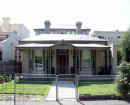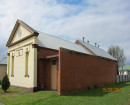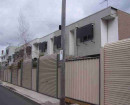BAND ROTUNDA
BEACH STREET (OPPOSITE STOKES STREET) PORT MELBOURNE, PORT PHILLIP CITY
-
Add to tour
You must log in to do that.
-
Share
-
Shortlist place
You must log in to do that.
- Download report




Statement of Significance
The Port Melbourne Band Rotunda was built in 1918 and officially opened on 27 October 1918. It was presented to the council by the Port Melbourne Women's Welcome Home Committee in honour of the Australians who fought in the First World War. The committee met the cost of construction from their own subscriptions.
The band rotunda is an octagonal structure constructed of red brick with timber posts and ceiling and a sheet-metal, domed roof surmounted by a flagpole. The platform is reached by a tapering staircase. There are seats on the other seven sides of the rotunda. The rotunda commands a prominent site on the foreshore.
How is it significant?
The Band Rotunda has social, historical and architectural significance to the State of Victoria.
Why is it significant?
The band rotunda has historical associations with the First World War and the community's commemoration of the event. The rotunda, along with band rotundas at Fitzroy and Natimuk, is a comparatively unusual memorial to the war and an early First World War memorial. The location of the rotunda is particularly poignant as Port Melbourne was the point of embarkation and disembarkation for troops during the First World War.
The rotunda has social significance as an expression of a once popular form of entertainment in parks and gardens. It symbolises the importance of music in the cultural and social life of the community in the nineteenth and early twentieth centuries.
The rotunda has architectural significance as an intact example of a band rotunda with a distinctive roof, a pyramidal form supported by timber columns and surmounted by a domed cupola terminating in a flagpole. The rotunda, with its picturesque and exotic composition, is an important element of the Port Melbourne foreshore.
-
-
BAND ROTUNDA - History
Contextual History:History of Place:
History of Place:
The Port Melbourne Band Rotunda was built in 1923? It was presented by the Port Melbourne Women’s Welcome Home Committee in honour of the Australians who fought in the First World War.BAND ROTUNDA - Permit Exemptions
General Exemptions:General exemptions apply to all places and objects included in the Victorian Heritage Register (VHR). General exemptions have been designed to allow everyday activities, maintenance and changes to your property, which don’t harm its cultural heritage significance, to proceed without the need to obtain approvals under the Heritage Act 2017.Places of worship: In some circumstances, you can alter a place of worship to accommodate religious practices without a permit, but you must notify the Executive Director of Heritage Victoria before you start the works or activities at least 20 business days before the works or activities are to commence.Subdivision/consolidation: Permit exemptions exist for some subdivisions and consolidations. If the subdivision or consolidation is in accordance with a planning permit granted under Part 4 of the Planning and Environment Act 1987 and the application for the planning permit was referred to the Executive Director of Heritage Victoria as a determining referral authority, a permit is not required.Specific exemptions may also apply to your registered place or object. If applicable, these are listed below. Specific exemptions are tailored to the conservation and management needs of an individual registered place or object and set out works and activities that are exempt from the requirements of a permit. Specific exemptions prevail if they conflict with general exemptions. Find out more about heritage permit exemptions here.Specific Exemptions:EXEMPTIONS FROM PERMITS:
(Classes of works or activities which may be undertaken without a permit under
Part 4 of the Heritage Act 1995)
General Conditions:
1. All exempted alterations are to be planned and carried out in a manner
which prevents damage to the fabric of the registered place or object.
2. Should it become apparent during further inspection or the carrying out of
alterations that original or previously hidden or inaccessible details of the
place or object are revealed which relate to the significance of the place or
object, then the exemption covering such alteration shall cease and the
Executive Director shall be notified as soon as possible.
3. If there is a conservation policy and plan approved by the Executive
Director, all works shall be in accordance with it.
4. Nothing in this declaration prevents the Executive Director from amending
or rescinding all or any of the permit exemptions.
5. Nothing in this declaration exempts owners or their agents from the
responsibility to seek relevant planning or building permits from the
responsible authority where applicable.
* Minor repairs and maintenance which replace like with like.
* Repairs to plumbing provided that they do not damage the fabric of the
fountain.
* Laying or removal of concrete or bitumen paving within the registered land.
-
-
-
-
-
PORT MELBOURNE COURT HOUSE, POLICE STATION AND LOCK-UP
 Victorian Heritage Register H1318
Victorian Heritage Register H1318 -
FORMER SWALLOW & ARIELL BISCUIT FACTORY
 Victorian Heritage Register H0567
Victorian Heritage Register H0567 -
JUBILEE TERRACE
 Victorian Heritage Register H1829
Victorian Heritage Register H1829
-
1 Brockenshire Street
 Yarra City
Yarra City -
1 Bundara Street
 Yarra City
Yarra City -
1 Forster Street
 Hobsons Bay City
Hobsons Bay City
-
-
Notes See all notes
The Women's Welcoming Committee
26/10/15
'Welcoming the Wounded Anzacs' by Terry Keenan describes the work of the Womens Welcoming Committee in as much detail as the scant records allow. They met each and every returning ship returning with soldiers with small gifts of flowers and cigarettes. For a summary of their work go to http://portmelbfirstworldwar100.org.au/womens-welcoming-committee/ Janet Bolitho on behalf of the Port Melbourne Historical and Preservation Society
Public contributions
Notes See all notes
The Women's Welcoming Committee
26/10/15
'Welcoming the Wounded Anzacs' by Terry Keenan describes the work of the Womens Welcoming Committee in as much detail as the scant records allow. They met each and every returning ship returning with soldiers with small gifts of flowers and cigarettes. For a summary of their work go to http://portmelbfirstworldwar100.org.au/womens-welcoming-committee/ Janet Bolitho on behalf of the Port Melbourne Historical and Preservation Society












